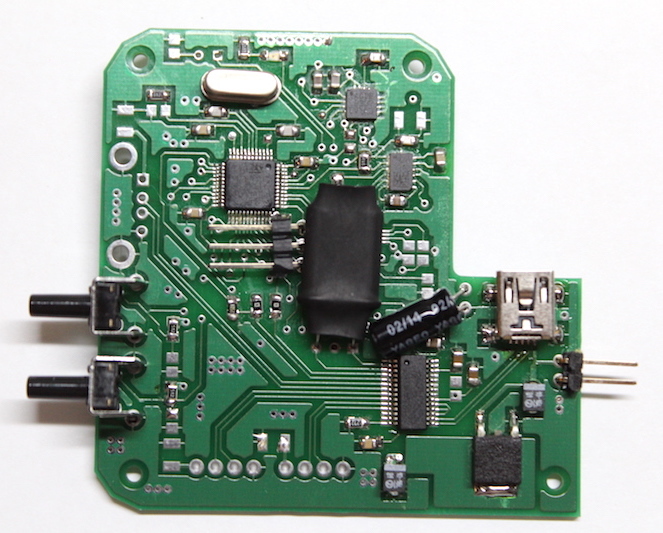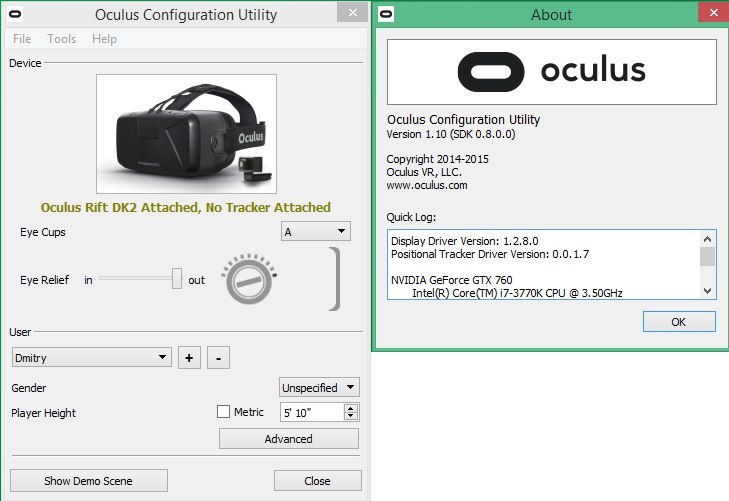VRD catches up with Oculus Rift DK2
November 13, Friday, 22 hours, and all normal people are already resting at home ... Nikolai is still in the office, makes another attempt to change the program, compiles, uploads the firmware to the controller and, lo and behold, Runtime 0.8 finally recognized the VRD helmet as Oculus Rift DK2. We immediately frantically try to launch the official demo application and understand that finally everything works. Frankly, for us it was a difficult and time-consuming task, but we managed to do it. The sensor board is now fully compatible with almost all Oculus Rift DK2 applications and works right up to the latest versions of Runtime.
Demo from Epic Games:
It all started about a year ago in the depths of Siberia, but I will not describe in detail the whole stage, since it can be tracked on articles at geektimes one , two , three .
There were really a lot of interesting points. This summer I had to learn SMD soldering and surface mounting skills, STM32 programming and other fun things that should be included in the set of, perhaps, everyone who wants to repeat this.
Without going into all serious, I will only briefly describe that the path was long and thorny, chopped a lot of firewood, broke a rake, etc. However, with the efforts of essentially 4 people, we made our VR tracking solution compatible with Oculus DK2 and the latest Runtimes:

The microcontroller STM32F103C8, the gyroscope L3GD20, the magnetometer + accelerometer LSM303DLHC are taken as the basis. It was this chipset that seemed to us the most familiar and affordable. In addition, the STM32F3Discovery debug board has similar ones on its board, which greatly simplifies debugging. Knowledgeable people may notice that both the set of sensors and the motherboard are fundamentally different from the Oculus DK1 or DK2 solution. Yes, our goal was not to clone Oculus Rift, we were interested in our own solution that Oculus can support now, tomorrow Vive, the day after tomorrow something else is possible. I can only say that no one forbids the data format to be implemented independently. Oculus package format - also not subject to patenting. This is just an ordered set of bytes. Yes, we spent a lot of time to understand how to make it work.
Well, the final goal, of course, is its own set of SDKs and Runtime.
However, iron is iron, but people need stereo content or games. And here, of course, at the moment, Oculus is ahead of the whole planet.
There is no doubt that VR has a great future in the field of games, but now in the field of software a little more than ordered chaos is happening (the owners of the attractions VR and Oculus should understand us).
The simplest solution so far is the launch of games that officially support Oculus SDK 0.6 - 0.8 and we managed to achieve such compatibility:

Here, for example, a demonstration of work in the already notorious Back to Dinosaur Island from CryTek:
Some games that are not directly supported by Oculus Runtime can be launched via 3Def3D or VorpX (commercial third-party video drivers).
Finally, my favorite video is the work of Fallout 4 in a helmet through VorpX:
The sensations of a nuclear explosion that you observe literally with your own eyes can not be expressed in words. Frankly, I was always interested in what it is ...
Of course, we are not able to test all the games because we are very busy with direct development.
Summing up, I can state a fact - virtual reality has really become closer and more accessible. I think that 2016 will bring a lot of new events in the VR world and this technology will begin its march on the planet.
There are many plans for 2016. I think all the fun is yet to come!
Demo from Epic Games:
We are from Siberia
It all started about a year ago in the depths of Siberia, but I will not describe in detail the whole stage, since it can be tracked on articles at geektimes one , two , three .
Way
There were really a lot of interesting points. This summer I had to learn SMD soldering and surface mounting skills, STM32 programming and other fun things that should be included in the set of, perhaps, everyone who wants to repeat this.
Without going into all serious, I will only briefly describe that the path was long and thorny, chopped a lot of firewood, broke a rake, etc. However, with the efforts of essentially 4 people, we made our VR tracking solution compatible with Oculus DK2 and the latest Runtimes:
The microcontroller STM32F103C8, the gyroscope L3GD20, the magnetometer + accelerometer LSM303DLHC are taken as the basis. It was this chipset that seemed to us the most familiar and affordable. In addition, the STM32F3Discovery debug board has similar ones on its board, which greatly simplifies debugging. Knowledgeable people may notice that both the set of sensors and the motherboard are fundamentally different from the Oculus DK1 or DK2 solution. Yes, our goal was not to clone Oculus Rift, we were interested in our own solution that Oculus can support now, tomorrow Vive, the day after tomorrow something else is possible. I can only say that no one forbids the data format to be implemented independently. Oculus package format - also not subject to patenting. This is just an ordered set of bytes. Yes, we spent a lot of time to understand how to make it work.
Well, the final goal, of course, is its own set of SDKs and Runtime.
Games, games, games and games again
However, iron is iron, but people need stereo content or games. And here, of course, at the moment, Oculus is ahead of the whole planet.
There is no doubt that VR has a great future in the field of games, but now in the field of software a little more than ordered chaos is happening (the owners of the attractions VR and Oculus should understand us).
The simplest solution so far is the launch of games that officially support Oculus SDK 0.6 - 0.8 and we managed to achieve such compatibility:

Here, for example, a demonstration of work in the already notorious Back to Dinosaur Island from CryTek:
Some games that are not directly supported by Oculus Runtime can be launched via 3Def3D or VorpX (commercial third-party video drivers).
Finally, my favorite video is the work of Fallout 4 in a helmet through VorpX:
The sensations of a nuclear explosion that you observe literally with your own eyes can not be expressed in words. Frankly, I was always interested in what it is ...
Of course, we are not able to test all the games because we are very busy with direct development.
Summing up, I can state a fact - virtual reality has really become closer and more accessible. I think that 2016 will bring a lot of new events in the VR world and this technology will begin its march on the planet.
There are many plans for 2016. I think all the fun is yet to come!
